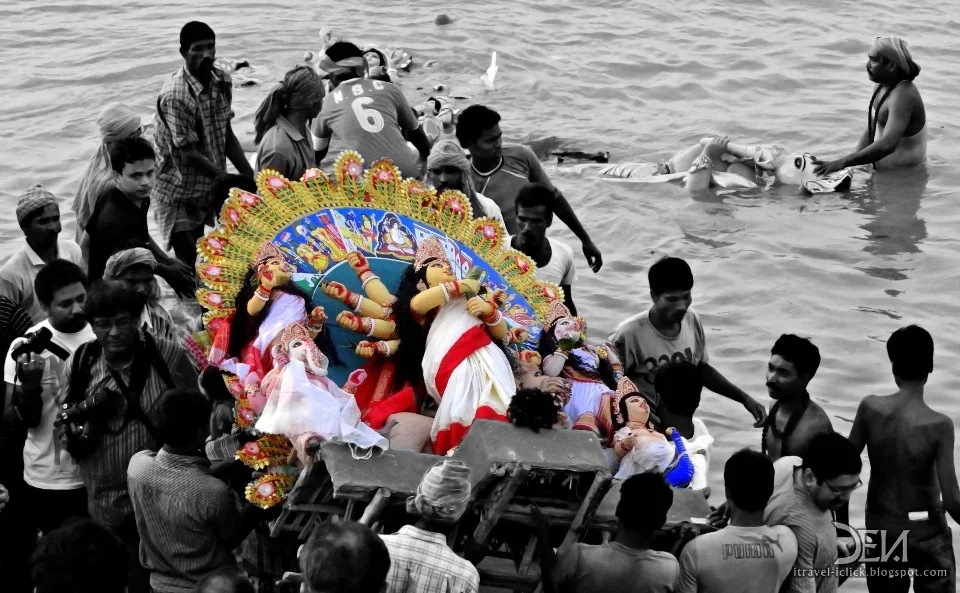A new step by the Green lobby to bury the idols..However will it get the support of our Hindu religious heads! What do sastras say?
[h=1]In green move, Durga idols to be buried[/h]Keshav Agarwal,TNN | Oct 3, 2014
PILIBHIT: Inspired by Prime Minister Narendra Modi's Clean India campaign, some devotees in Pilibhit district have undertaken to bury Durga idols instead of immersing them in rivers or canals.
The move, which is aimed at keeping water bodies free from contamination, came about after the PM's call, and also fervent appeals issued by the district police administration.
Police said a total of 28 places within the district have given an undertaking that they would not submerge the idols in water bodies on Friday and Saturday. More are expected to follow suit.
Moti Ranjan Rai, a resident of Bengali village Naujaliah under Madhotanda police station, said his village had a long tradition of immersing the Durga idol into Sharda river, but accepting social responsibility in national interest, the villagers have now decided to immerse the idol in a pond situated in the village.
Likewise, another villager, Heera Lal, of Dilawarpur village and the president of Dura Puja Samiti, said members of his committee had this year buried the idol near a canal, abandoning the old tradition of immersing it in the river.
Ram Prakash, a villager from Chanduia and the president of an NGO, Jan Kalyan Samiti, said breaking from tradition, villagers this year decided to enshrine the idol in a temple this year instead of immersing it.
ASP Udai Shankar Singh told TOI that the police administration had succeeded in getting the active cooperation of people in response to an appeal to not immerse the idols of Goddess Durga in rivers or canals.
However, religious heads, quoting ancient scriptures, said the idols or the remains of any ritual ceremony should be discharged only in running water especially in rivers.
A renowned Vastu expert in Pilibhit, Shyama Jeevan Goswami, said that Shakti, in the form of Goddess Laxmi, had originated from sea water at the time of 'Sagar Manathan' (churning of sea) striven by gods and demons in ancient time and therefore all the idols of Shakti should be discharged only in the water of sea or river.
Another religious head, Pandit Dinesh Chandra Joshi from Brahmpuri, Haridwar, claimed that the ancient religious traditions were based on the directives of scriptures, which were clear that religious material should only be immersed in holy rivers. These norms should not be debated, he added. However, police and locals have welcomed the break from tradition and expressed hope that it continues in coming years.
http://timesofindia.indiatimes.com/city/bareilly/In-green-move-Durga-idols-to-be-buried/articleshow/44239650.cms?utm_source=twitter.com&utm_medium=referral&utm_campaign=timesofindia
[h=1]In green move, Durga idols to be buried[/h]Keshav Agarwal,TNN | Oct 3, 2014
PILIBHIT: Inspired by Prime Minister Narendra Modi's Clean India campaign, some devotees in Pilibhit district have undertaken to bury Durga idols instead of immersing them in rivers or canals.
The move, which is aimed at keeping water bodies free from contamination, came about after the PM's call, and also fervent appeals issued by the district police administration.
Police said a total of 28 places within the district have given an undertaking that they would not submerge the idols in water bodies on Friday and Saturday. More are expected to follow suit.
Moti Ranjan Rai, a resident of Bengali village Naujaliah under Madhotanda police station, said his village had a long tradition of immersing the Durga idol into Sharda river, but accepting social responsibility in national interest, the villagers have now decided to immerse the idol in a pond situated in the village.
Likewise, another villager, Heera Lal, of Dilawarpur village and the president of Dura Puja Samiti, said members of his committee had this year buried the idol near a canal, abandoning the old tradition of immersing it in the river.
Ram Prakash, a villager from Chanduia and the president of an NGO, Jan Kalyan Samiti, said breaking from tradition, villagers this year decided to enshrine the idol in a temple this year instead of immersing it.
ASP Udai Shankar Singh told TOI that the police administration had succeeded in getting the active cooperation of people in response to an appeal to not immerse the idols of Goddess Durga in rivers or canals.
However, religious heads, quoting ancient scriptures, said the idols or the remains of any ritual ceremony should be discharged only in running water especially in rivers.
A renowned Vastu expert in Pilibhit, Shyama Jeevan Goswami, said that Shakti, in the form of Goddess Laxmi, had originated from sea water at the time of 'Sagar Manathan' (churning of sea) striven by gods and demons in ancient time and therefore all the idols of Shakti should be discharged only in the water of sea or river.
Another religious head, Pandit Dinesh Chandra Joshi from Brahmpuri, Haridwar, claimed that the ancient religious traditions were based on the directives of scriptures, which were clear that religious material should only be immersed in holy rivers. These norms should not be debated, he added. However, police and locals have welcomed the break from tradition and expressed hope that it continues in coming years.
http://timesofindia.indiatimes.com/city/bareilly/In-green-move-Durga-idols-to-be-buried/articleshow/44239650.cms?utm_source=twitter.com&utm_medium=referral&utm_campaign=timesofindia

